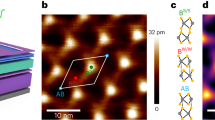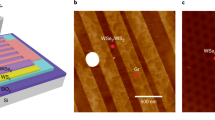Abstract
Transition metal dichalcogenide moiré heterostructures provide an ideal platform to explore the extended Hubbard model1, where long-range Coulomb interactions play a critical role in determining strongly correlated electron states. This has led to experimental observations of Mott insulator states at half filling2,3,4 as well as a variety of extended Wigner crystal states at different fractional fillings5,6,7,8,9. However, a microscopic understanding of these emerging quantum phases is still lacking. Here we describe a scanning tunnelling microscopy (STM) technique for the local sensing and manipulation of correlated electrons in a gated WS2/WSe2 moiré superlattice, which enables the experimental extraction of fundamental extended Hubbard model parameters. We demonstrate that the charge state of the local moiré sites can be imaged by their influence on the STM tunnelling current. In addition to imaging, we are also able to manipulate the charge state of correlated electrons. When we ramp the bias on the STM tip, there is a local discharge cascade of correlated electrons in the moiré superlattice, which allows us to estimate the nearest-neighbour Coulomb interaction. Two-dimensional mapping of the moiré electron charge states also enables us to determine the on-site energy fluctuations at different moiré sites. Our technique should be broadly applicable to many semiconductor moiré systems, offering a powerful tool for the microscopic characterization and control of strongly correlated states in moiré superlattices.
This is a preview of subscription content, access via your institution
Access options
Access Nature and 54 other Nature Portfolio journals
Get Nature+, our best-value online-access subscription
$29.99 / 30 days
cancel any time
Subscribe to this journal
Receive 12 print issues and online access
$209.00 per year
only $17.42 per issue
Buy this article
- Purchase on Springer Link
- Instant access to full article PDF
Prices may be subject to local taxes which are calculated during checkout




Similar content being viewed by others
Data availability
Source data are available for this paper at https://github.com/HongyuanLiCMP/Moire_discharging_STM_data. All other data that support the findings of this paper are available from the corresponding authors upon request.
References
Wu, F., Lovorn, T., Tutuc, E. & MacDonald, A. H. Hubbard model physics in transition metal dichalcogenide moiré bands. Phys. Rev. Lett. 121, 026402 (2018).
Wang, L. et al. Correlated electronic phases in twisted bilayer transition metal dichalcogenides. Nat. Mater. 19, 861–866 (2020).
Tang, Y. et al. Simulation of Hubbard model physics in WSe2/WS2 moiré superlattices. Nature 579, 353–358 (2020).
Shimazaki, Y. et al. Strongly correlated electrons and hybrid excitons in a moiré heterostructure. Nature 580, 472–477 (2020).
Regan, E. C. et al. Mott and generalized Wigner crystal states in WSe2/WS2 moiré superlattices. Nature 579, 359–363 (2020).
Jin, C. et al. Stripe phases in WSe2/WS2 moiré superlattices. Nat. Mater. 20, 940–944 (2021).
Xu, Y. et al. Correlated insulating states at fractional fillings of moiré superlattices. Nature 587, 214–218 (2020).
Huang, X. et al. Correlated insulating states at fractional fillings of the WS2/WSe2 moiré lattice. Nat. Phys. 17, 715–719 (2021).
Chu, Z. et al. Nanoscale conductivity imaging of correlated electronic states in WSe2/WS2 moiré superlattices. Phys. Rev. Lett. 125, 186803 (2020).
Liu, X. et al. Tunable spin-polarized correlated states in twisted double bilayer graphene. Nature 583, 221–225 (2020).
Lu, X. et al. Superconductors, orbital magnets and correlated states in magic-angle bilayer graphene. Nature 574, 653–657 (2019).
Cao, Y. et al. Correlated insulator behaviour at half-filling in magic-angle graphene superlattices. Nature 556, 80–84 (2018).
Zondiner, U. et al. Cascade of phase transitions and Dirac revivals in magic-angle graphene. Nature 582, 203–208 (2020).
Cao, Y. et al. Tunable correlated states and spin-polarized phases in twisted bilayer–bilayer graphene. Nature 583, 215–220 (2020).
Chen, G. et al. Evidence of a gate-tunable Mott insulator in a trilayer graphene moiré superlattice. Nat. Phys. 15, 237–241 (2019).
Slagle, K. & Fu, L. Charge transfer excitations, pair density waves, and superconductivity in moiré materials. Phys. Rev. B 102, 235423 (2020).
Zhang, Y., Yuan, N. F. & Fu, L. Moiré quantum chemistry: charge transfer in transition metal dichalcogenide superlattices. Phys. Rev. B 102, 201115 (2020).
Li, H. et al. Imaging moiré flat bands in three-dimensional reconstructed WSe2/WS2 superlattices. Nat. Mater. 20, 945–950 (2021).
Zhang, C. et al. Probing critical point energies of transition metal dichalcogenides: surprising indirect gap of single layer WSe2. Nano Lett. 15, 6494–6500 (2015).
Jung, S. et al. Evolution of microscopic localization in graphene in a magnetic field from scattering resonances to quantum dots. Nat. Phys. 7, 245–251 (2011).
Pradhan, N. A., Liu, N., Silien, C. & Ho, W. Atomic scale conductance induced by single impurity charging. Phys. Rev. Lett. 94, 076801 (2005).
Brar, V. W. et al. Gate-controlled ionization and screening of cobalt adatoms on a graphene surface. Nat. Phys. 7, 43–47 (2011).
Wong, D. et al. Characterization and manipulation of individual defects in insulating hexagonal boron nitride using scanning tunnelling microscopy. Nat. Nanotechnol. 10, 949–953 (2015).
Teichmann, K. et al. Controlled charge switching on a single donor with a scanning tunneling microscope. Phys. Rev. Lett. 101, 076103 (2008).
Geick, R., Perry, C. & Rupprecht, G. Normal modes in hexagonal boron nitride. Phys. Rev. 146, 543–547 (1966).
Acknowledgements
This work was funded by the US Department of Energy, Office of Science, Office of Basic Energy Sciences, Materials Sciences and Engineering Division, under contract no. DE-AC02-05-CH11231 (van der Waals heterostructure programme KCFW16) (device electrode preparation, STM spectroscopy, DFT calculations and theoretical analysis). Support was also provided by the US Army Research Office under MURI award W911NF-17-1-0312 (device layer transfer), by the National Science Foundation award DMR-1926004 (structural determination) and by the National Science Foundation award DMR-1807233 (surface preparation). S.T. acknowledges support from DOE-SC0020653 (materials synthesis), Applied Materials Inc., NSF CMMI 1825594 (NMR and TEM studies), NSF DMR-1955889 (magnetic measurements), NSF CMMI-1933214, NSF 1904716, NSF 1935994, NSF ECCS 2052527, DMR 2111812 and CMMI 2129412. K.W. and T.T. acknowledge support from the Elemental Strategy Initiative conducted by MEXT, Japan, grant number JPMXP0112101001; JSPS KAKENHI grant number JP20H00354; and CREST (JPMJCR15F3), JST, for bulk hBN crystal growth and analysis. E.R. acknowledges support from the Department of Defense (DoD) through the National Defense Science and Engineering Graduate Fellowship (NDSEG) programme. S.L. acknowledges support from Kavli ENSI Heising-Simons Junior Fellowship. M.H.N. thanks S. Kundu and M. Jain for their implementation of non-collinear wave-function plotting in Siesta.
Author information
Authors and Affiliations
Contributions
F.W. and M.F.C. conceived the project. S.G.L. supervised the theoretical calculations. H.L. and S.L. performed the STM measurement. M.H.N. carried out the DFT calculations. H.L., J.X., X.L., W.Z., E.R. and D.W. fabricated the heterostructure device and performed the second harmonic generation measurement. K.Y., M.B. and S.T. grew the WSe2 and WS2 crystals. K.W. and T.T. grew the hBN single crystal. All the authors discussed the results and wrote the manuscript.
Corresponding authors
Ethics declarations
Competing interests
The authors declare no competing interests.
Additional information
Peer review information Nature Physics thanks Kam Tuen Law and the other, anonymous, reviewer(s) for their contribution to the peer review of this work.
Publisher’s note Springer Nature remains neutral with regard to jurisdictional claims in published maps and institutional affiliations.
Supplementary information
Supplementary Information
Supplementary Figs. 1–5 and Discussion.
Rights and permissions
About this article
Cite this article
Li, H., Li, S., Naik, M.H. et al. Imaging local discharge cascades for correlated electrons in WS2/WSe2 moiré superlattices. Nat. Phys. 17, 1114–1119 (2021). https://doi.org/10.1038/s41567-021-01324-x
Received:
Accepted:
Published:
Issue Date:
DOI: https://doi.org/10.1038/s41567-021-01324-x
This article is cited by
-
Mapping charge excitations in generalized Wigner crystals
Nature Nanotechnology (2024)
-
Imaging moiré excited states with photocurrent tunnelling microscopy
Nature Materials (2024)
-
Strong signature of electron-vibration coupling in molecules on Ag(111) triggered by tip-gated discharging
Nature Communications (2023)
-
Distinct moiré textures of in-plane electric polarizations for distinguishing moiré origins in homobilayers
Science China Physics, Mechanics & Astronomy (2023)
-
Strong correlations in two-dimensional transition metal dichalcogenides
Science China Physics, Mechanics & Astronomy (2023)



